The number of dengue cases this year has risen sharply in the last four weeks, and is expected to exceed the 15,998 cases reported in 2019. The total number of dengue cases this year may even surpass the peak of 22,170 cases reported in 2013. Urgent collective community effort is critical, to prevent the number of dengue cases from rising further.
Singapore, 3 June 2020 – As of 2 June 2020, there have been 9,261 reported dengue cases this year. This is the highest for the same period of the year since 2013, the largest outbreak year recorded in Singapore’s recent history. The weekly number of reported dengue cases this year has climbed steadily from 300 to 400 cases from January to April, to 735 cases last week (see Figure 1). Singapore has not seen such a high weekly number of dengue cases since the peak years in 2013 and 2014. The number of dengue cases this year is expected to exceed the 15,998 cases reported in 2019, and may even surpass the 22,170 cases reported in 2013. As of 2 June 2020, the Ministry of Health (MOH) has been notified of 12 dengue deaths in 2020, ranging between 56 and 80 years old. Of these cases, 10 worked or resided in active dengue cluster areas. Urgent collective community effort is needed to drastically reduce mosquito breeding habitats and slow down the rise in the number of dengue cases.
Factors leading to the dengue surge this year
2 A confluence of factors is contributing to the recent spike in dengue cases. First, an increase in the less common Dengue virus serotype 3 (DENV-3) since the beginning of this year. This serotype was last seen in a dominant position in Singapore about three decades ago, which means there is low immunity in our population and a rapid disease transmission. This likely explains the unusually high number of weekly cases, hovering between 300 to 400, since the start of the year.
3 Second, we are entering the traditional dengue peak season, with the warmer weather facilitating faster multiplication of the Aedes aegypti mosquito and dengue virus, increasing the chances of dengue transmission. The mean temperature in the last three months is about 1◦C higher than the preceding months. Third, NEA’s Gravitrap surveillance system has revealed more areas with high Aedes aegypti mosquito populations. These two factors would have carried forward the momentum of the high dengue cases in the first four months of this year, and partly contributed to the recent spike in weekly dengue cases.
4 Last but not least, the dengue spike occurred over a short four-week period since early May 2020, and coincided with the Circuit Breaker period. The main vector of dengue – the Aedes aegypti mosquito – dwells mainly in indoor spaces and primarily bites during the day. With a shift in human concentration from offices to homes, more people staying at home during the day also means more blood meals for the female Aedes aegypti mosquitoes, especially in residential areas where the mosquito population is also high. Together with the availability of breeding habitats for the mosquitoes, this produced even more mosquitoes. This has likely exacerbated the situation, leading to the sharp rise in the number of dengue infections in the past four weeks.
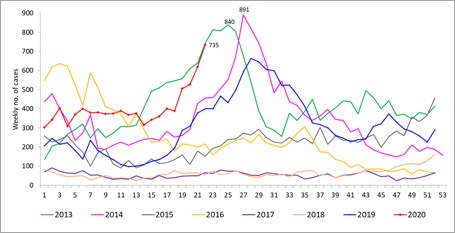
Figure 1. Annual trend of dengue cases, from 2013 to 2020
Expanded dengue prevention efforts this year
5 NEA takes a multi-pronged approach to dengue control, comprising vector control measures, stakeholder engagement, as well as community mobilisation and public communications. In anticipation of the surge this year, several new efforts have been undertaken this year and are ongoing:
a. NEA completed roll-out of the Gravitrap surveillance system to landed estates in early 2020. This enhanced surveillance complements the Gravitrap surveillance data collected from HDB estates, and has enabled NEA to conduct more targeted and effective inspections and vector control operations.
b. The National Dengue Prevention Campaign launch was brought forward from April to March 2020, to alert residents early on the need to fight dengue ahead of the start of the dengue peak season.
c. With the COVID-related measures limiting face-to-face engagement efforts, besides ramping up dengue prevention outreach via digital and mobile platforms, additional efforts were also taken to directly reach out to residents. For example, in partnership with the People’s Association (PA), close to one million dengue prevention leaflets were distributed directly to residents with the second round of reusable masks. SMS blasts were also rolled out in April at targeted dengue clusters, to remind residents to check their homes for stagnant water and do the Mozzie Wipeout.
d. As visual cues within neighbourhoods have been found to be effective in creating awareness, NEA has deployed more dengue alert banners at dengue cluster areas, and is also rolling out dengue posters at the HDB block level.
e. NEA has additionally worked with the Ministry of Health (MOH), Polyclinics and General Practitioners (GPs), to provide over 300,000 bottles of mosquito repellent for distribution to patients who are suspected to have dengue, in May 2020; so as to prevent the further spread of dengue. The messages on spraying aerosol insecticide in dark corners of the home have also been enhanced, to educate residents on how to protect themselves and their loved ones.
Mosquito inspections in homes to safeguard public health
6 As the traditional dengue peak season could last a few months, from June to October, immediate action must be taken to break disease transmission. Urgent national collective effort is thus needed, especially given the various aggravating factors at play this year. As the majority of mosquito breeding is found in homes, NEA urgently seeks the community’s support to ensure that their homes (including corridors where domestic items, such as potted plants and pails, are kept) and gardens in their compounds are free from mosquito breeding; and to use aerosol insecticide spray and mosquito repellent to protect themselves and their families.
7 From January to May this year[1], NEA conducted about 341,000 inspections for mosquito breeding islandwide, and uncovered about 7,800 mosquito breeding habitats. NEA has observed a five-fold increase in the incidence of Aedes mosquito larvae detected in homes and common corridors in residential areas during the two-month Circuit Breaker period compared to the two months prior. The highest percentage of mosquito breeding found in homes in the top five dengue cluster areas was 84 per cent (refer to Annex A for inspection findings at the top five dengue cluster areas).
8 Controlling the vector is a key strategy in our fight against dengue, as the Dengue virus is endemic in Singapore and we have largely no control over the other key enabling factors, like warmer weather and population immunity. Hence despite the Circuit Breaker measures, NEA officers have continued with inspections of homes, construction sites and other premises. Homeowners and occupants are strongly urged to do their part too, pay close attention to any mosquito breeding or adult mosquitoes present in their homes, and take the necessary steps to prevent or remove them. This includes regularly doing the Mozzie Wipeout and removing any stagnant water, applying mosquito repellent to protect themselves from mosquito bites, and spraying insecticide at adult mosquitoes harbouring at home.
9 All residents living in dengue cluster areas are strongly encouraged to cooperate with NEA officers, and facilitate their checks and indoor misting in their homes. As the Aedes aegypti mosquito has adapted well to the urban environment and dwells mainly in indoor spaces, it is critical to eradicate mosquito breeding habitats and adult mosquitoes in homes, to break disease transmission. Allowing NEA to access all homes in dengue cluster areas as quickly as possible helps keep your family members, neighbours and the community safe from being infected with the Dengue virus (refer to Annex B for photos of NEA officers conducting dengue control operations).
10 “As we continue to manage the COVID-19 situation, we need to be mindful that dengue is another serious public health threat that Singapore faces. We have entered the traditional peak dengue season, when we experience the onset of warmer weather and see higher transmission of dengue in Singapore. During our inspections, we continue to find mosquito breeding in common habitats, such as flower pot plates and domestic containers. Lack of care or diligence in maintaining one’s premises or home could easily lead to mosquito breeding, putting the whole community at risk. Weekly dengue case numbers are likely to continue to rise, and more dengue clusters will form in the coming weeks to months. NEA will continue with our inspection and enforcement efforts, and we will not hesitate to take action against anyone found to have created conditions favourable for the propagation or harbouring of vectors. All of us must do our part in our collective fight against dengue,” said Mr Chew Ming Fai, Director-General of NEA’s Environmental Public Health Division.
Focused efforts at construction sites
11 Preventive surveillance has also been stepped up at construction sites, given their closure during the Circuit Breaker period. Before the start of the Circuit Breaker, construction site operators were instructed to maintain a minimum workforce to perform housekeeping and facilitate pest control services within the sites. NEA has prioritised audits at higher risk construction sites, such as those within dengue clusters and residential areas, as well as sites with past records of having been found breeding mosquitoes. 82 per cent of these sites have been inspected since the start of the Circuit Breaker period. NEA has observed a two-fold increase in the incidence of Aedes mosquito larvae detected at construction sites during the Circuit Breaker period. From January to May this year [2], 52 summonses and two Stop Work Orders (SWOs) were issued to construction sites, and two contractors will be charged in court for repeat offences.
Call for urgent collective community action to eliminate potential mosquito breeding habitats
12 Since March this year, given the projection of a high number of dengue cases, the various agencies and other stakeholders represented in the Inter-Agency Dengue Task Force (IADTF), including Town Councils, have stepped up checks to remove potential mosquito breeding habitats at our public areas and housing estates. Since August 2019, NEA has shared with Town Councils and other stakeholders information on areas with higher Aedes aegypti mosquito populations [www.nea.gov.sg/dengue-zika/Aedes]. This is to enable stepped-up preventive measures to be taken early to prevent dengue clusters from forming.
13 We encourage everyone to be an advocate of dengue prevention, and to remind his or her family members and neighbours to join in the collective effort to help stop dengue transmission, by regularly doing the Mozzie Wipeout. All of us, including residents, contractors, and business owners, have a part to play in preventing dengue. NEA has developed a ‘Check and Protect’ checklist, highlighting common mosquito breeding habitats. It will be distributed via grassroots and partners’ networks, and will be available for download [go.gov.sg/dengue-checklist]. The latest updates on the dengue situation can be found on the NEA website, Stop Dengue Now Facebook page, and myENV app. The public can also download the myENV app to get regular alerts on dengue clusters and areas with higher Aedes aegypti mosquito population.
~~ End ~~
For more information, please submit your enquiries electronically via the
Online Feedback Form or
myENV mobile application. Alternatively, you contact us at 6225 5632.
[1] Provisional Figures as at 28 May 2020
[2] Provisional Figures as at 28 May 2020
ANNEX A
Inspection Findings at the Top Five Largest Dengue Clusters
Information as of 2 Jun 2020
S/N. | Cluster Locality | - No. of cases - Date of Notification - Proportion of Mosquito Breeding in Homes | Examples of Mosquito Breeding Detected |
1 | Woodleigh Cl (8 @ Woodleigh, Blossoms @ Woodleigh, Euro-Asia Pk, Parc Mondrian) / CS @ Woodleigh Ln / Woodleigh Ln, Pk / Youngberg Ter (Avon Pk) | - 181 - 31 Mar 2020 - 43% | 6 instances of profuse mosquito breeding detected in homes in flower pot plate/ tray, planter box, toilet bowl,vase and gully traps of 50 larvae or more each. |
2 | Tampines Ave 7 (Blk 390, 391, 392, 393, 396) / Tampines St 32 (Blk 325, 328, 330, 331, 336, 337, 381, 384, 385, 386, 387, 388) / Tampines St 33 (Blk 311, 352, 353, 354, 356, 357, 358) / Tampines St 34 (Blk 363, 364, 371, 372, 373, 374)/Tampines St 34(The Eden at Tampines) | - 119 - 20 Apr 2020 - 55% | 3 instances of profuse mosquito breeding detected in homes in ornamental container, flower pot plate/tray and plastic sheet cover of 50 larvae or more each. |
3 | Chu Lin Rd / Elizabeth Dr / Elizabeth Dr (Hillvista) / Hillview Ave (Chantilly Rise, Hillbrooks, Hillview 128, Hillview Residence) / Jln Dermawan / Jln Gumilang / Jln Intan / Jln Remaja / Jln Zamrud / Lor Kemunchup | - 96 - 6 Mar 2020 - 84% | 15 instances of profuse mosquito breeding detected in homes in canvas sheet, domestic containers (e.g. bowl, plastic container), vase, flower pot plate, fountain, small pool of 50 larvae or more each. |
4 | Aljunied Rd / Geylang Rd / GeylangEastAve1 / Geylang East Ctrl (Blk122) Guillemard Rd / Jln Molek / Jln Suka / Lor 22, 24, 25A, 27, 27A, 28, 30 Geylang / Sims Ave | - 94 - 21 Feb 2020 - 54% | 6 instances of profuse mosquito breeding detected in homes in plastic pail, cooking pot, sump pit, jacuzzi of 50 larvae or more each. |
5 | Potong Pasir Ave 1 (Blk 102, 104, 105, 106, 107, 108, 109, 121, 122, 123, 124, 125, 126, 127, 131, 146, 148) / Potong Pasir Ave 2 (Blk 144, 145) / Potong Pasir Ave 3 (Blk 134, 135, 136, 137, 138, 139, 140, 141) | - 87 - 21 Apr 2020 - 63% | 10 instances of profuse mosquito breeding detected in homes in domestic containers (e.g. pail), fish tank, vase, flower pot of 50 larvae or more each. |
ANNEX B
Photos of NEA Officers Conducting Dengue Control Operations
High-resolution photos available upon request
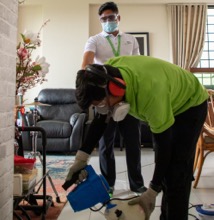
Photo1: NEA officers conducting indoor Ultra-Low Volume (ULV) misting at the Woodleigh Close dengue cluster | 
Photo 2: NEA officers conducting fogging at the Woodleigh Close dengue cluster |

Photo 3: NEA dengue inspection officer applying larvicide to a drain, at residential premises | 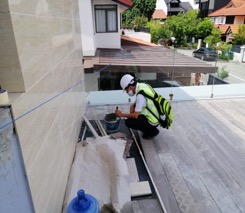
Photo 4: NEA dengue inspection officer checking for mosquito breeding at the roof top of residential premises |
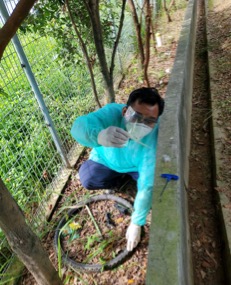
Photo 5: NEA dengue inspection officer checking for mosquito breeding in a discarded bicycle tyre, found in a drain in a dormitory | 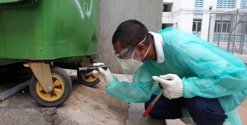
Photo 6: NEA dengue inspection officer checking for mosquito breeding under a refuse bin |
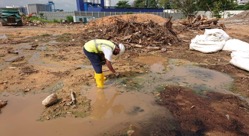
Photo 7: NEA dengue inspection officer checking for mosquito breeding at a construction site after a rainy day | 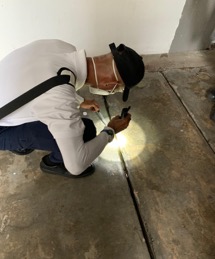
Photo 8: NEA dengue inspection officer checking for mosquito breeding at common areas of a residential estate |